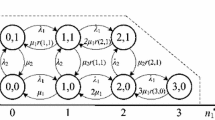Abstract
In modern telephone exchanges, subscriber lines are usually connected to the so-called subscriber line modules. These modules serve both incoming and outgoing traffic. An important difference between these two types of calls lies in the fact that in the case of blocking due to all channels busy in the module, outgoing calls can be queued whereas incoming calls get busy signal and must be re-initiated in order to establish the required connection. The corresponding queueing model was discussed recently by Lederman, but only the model with losses has been studied analytically. In the present contribution, we study the model which takes into account subscriber retrials and investigate some of its properties such as existence of stationary regime, derive explicit formulas for the system characteristics, limit theorems for systems under high repetition intensity of blocked calls and limit theorems for systems under heavy traffic.
Similar content being viewed by others
References
B.D. Choi and K.K. Park, TheM/G/1 retrial queue with Bernoulli schedule, Queueing Systems 7 (1990) 219.
R. Davis, Waiting-time distribution of a multiserver priority queue system, Oper. Res. 14 (1966).
G.I. Falin, On sufficient conditions for ergodicity of multichannel queueing systems with repeated calls, Adv. Appl. Prob. 16 (1984) 447.
G.I. Falin, Multichannel queueing systems with repeated calls under high intensity of repetition, J. Inf. Process. Cybern. EIK 23 (1987) 37.
S. Lederman, Congestion model for subscriber line modules,GLOBECOM'85, IEEE Global Telecommunication Conf., vol. 1, New Orleans (1985) p. 395.
S.N. Stepanov, Increase the efficiency of numerical methods for models with repeat calls, Probl. Infor. Transmission 22 (1986) 78.
Y. Takahashi and T. Katayama, Multi-server system with batch arrivals of queueing and non-queueing calls,Teletraffic Issues in an Advanced Information Society (Proc. ITC-11) (Elsevier Science, 1985) p. 394.
R.L. Tweedie, Sufficient conditions for regularity, recurrence and ergodicity of Markov processes, Math. Proc. Cambridge Phil. Soc. 78, part 1 (1975) 125.
Author information
Authors and Affiliations
Rights and permissions
About this article
Cite this article
Khalil, Z., Falin, G. & Yang, T. Some analytical results for congestion in subscriber line modules. Queueing Syst 10, 381–402 (1992). https://doi.org/10.1007/BF01193327
Received:
Revised:
Issue Date:
DOI: https://doi.org/10.1007/BF01193327




